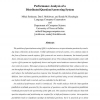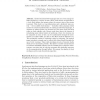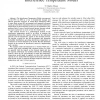612 search results - page 102 / 123 » Rate-Based Resource Allocation Models for Embedded Systems |
IPTPS
2003
Springer
14 years 1 months ago
2003
Springer
Much of the existing work in peer to peer networking assumes that users will follow prescribed protocols without deviation. This assumption ignores the user’s ability to modify ...
GECCO
2005
Springer
14 years 1 months ago
2005
Springer
A fuzzy logic algorithm has been developed that automatically allocates electronic attack (EA) resources distributed over different platforms in real-time. The controller must be ...
TPDS
2002
13 years 7 months ago
2002
The problem of question/answering (Q/A) is to find answers to open-domain questions by searching large collections of documents. Unlike information retrieval systems, very common ...
APLAS
2008
ACM
13 years 10 months ago
2008
ACM
ion of Clocks in Synchronous Data-flow Systems Albert Cohen1 , Louis Mandel2 , Florence Plateau2 , and Marc Pouzet23 1 INRIA Saclay - Ile-de-France, Orsay, France 2 LRI, Univ. Pari...
INFOCOM
2007
IEEE
14 years 2 months ago
2007
IEEE
— The Interference Temperature Model was proposed by the FCC in 2003 as a way to dynamically manage and allocate spectrum resources. It would allow unlicensed radios to sense the...




